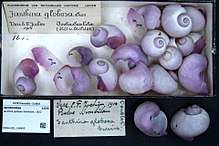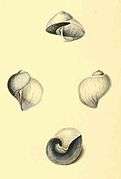Janthina globosa
Janthina globosa is a species of holoplanktonic sea snail, a marine gastropod mollusk in the family Epitoniidae, the violet snails or purple storm snails. [1]
| Janthina globosa | |
|---|---|
 | |
| Jathina globosa shells | |
| Scientific classification | |
| Kingdom: | Animalia |
| Phylum: | Mollusca |
| Class: | Gastropoda |
| Clade: | Caenogastropoda |
| Superfamily: | Epitonioidea |
| Family: | Epitoniidae |
| Genus: | Janthina |
| Species: | J. globosa |
| Binomial name | |
| Janthina globosa Swainson, 1822 | |
| Synonyms[1] | |
| |
Anatomy and Morphology
Janthina globosa, commonly referred to as the violet snail, is a neustonic organism characterized by its thin, fragile purple shell and large size The maximum recorded shell length is 38.5 mm.[2] Females normally grow to larger sizes than males, making it easy to distinguish between the sexes. Janthina globosa has a glossy shell, characterized by four symmetrical spirals evenly spaced on its shell. Inside its shell lives the organism itself. Protected by its hard outer shell, Janthina globosa has a soft body with forked cephalic tentacles on its belly, used for many different things like locomotion and receiving sensory input. Its unique purple color serves to camouflage itself in its environment and also serves as an efficient means of obtaining food, making it a better predator. It and many other members of the Janthina genera have an epipodium that is thought to help with balance in the water (Wilson and Wilson, 1956, 301).
Feeding and Preferred Prey
It secretes a purple dye (the same dye that gives it its purple color) to paralyze its prey, allowing it to eat its target without much of a fight. Although Janthina globosa seems like a harmless snail, it is an incredibly successful predator. Its most popular prey, based on scientific observation, seems to be Velella (Wilson and Wilson, 1956, 301) . Although scientists have observed that Velella is its favored prey option, upon gut analysis it seems that Janthina globosa will eat just about anything, even exhibiting cannibalistic behaviors by eating members of its own species.
Velella has stinging nematocysts that they use to defend themselves and to capture prey. Janthina globosa are able to tolerate the poison excreted from Velella’s nematocysts, making them an easy target for predation by Janthina globosa. Unlike many other marine animals, Janthina globosa’s diet does not change too much as it matures. Janthina globosa seems to prefer larger Velella over smaller bodied Velella due to the availability of more soft tissue to eat as compared to the smaller members of that species. Since Velella is their preferred prey, Janthina globosa will appear in places it is not normally found if there is a large amount of Velella prey to consume. This makes the population size of Velella a good predictor of Janthina globosa location and population size (Deudero S, Pinnegar J, Polunin N. 2002).
Distribution and Habitat
Four other species that fall in the genera Janthina can be found in the Mediterranean Sea (along with Janthina globosa) but they are also found between these latitudes: 50°N and 40°S. If conditions permit it, these snails can be found outside these latitudes. Strandings of this species and others of its genera are also due to wave and current movements (F. Betti et al 2017). Minimum recorded depth is 0 m.[2] Maximum recorded depth is 13 metres (43 ft).[2]
Taxonomy
Janthina globosa was first captured in 1822 off the Gulf of Antalya in the Northeastern part of the Mediterranean Sea (Teker S, Gökoğlu M , Julian D. 2017). The oldest fossil of the Janthina genera was found on the Santa Maria Island in the Atlantic but it is unclear the earliest record of Janthina globosa specifically, despite its long fossil record (Record of the Australian Museum, 2017, 142). It is thought that Janthina globosa was used as a source of purple dye for clothes in ancient times. Many other species fall in the genera Janthina and it most likely evolved from the species J. krejcii but looks more like J. pallida (Record of the Australian Museum, 2017, 160-161).
Behavior
This species lives its life upside down attached to air bubbles that it made itself, forming a self-made float. These air bubbles are produced by a specialized organ called the propodium. This organ sucks air from above the surface of the water to create a bubble. It then coats it with a covering of mucus before adding it to the bottom of the float. It is further adhered to the float with more mucus to ensure it is secure. This bubble making process has been timed and it took one organism of the Janthina genera about a minute to completely form one bubble (Wilson and Wilson, 1956, 300). This mechanism of staying afloat is almost entirely unique to the Janthina genera, with the one exception being the Recluzia. Janthina globosa is not restricted to living in the open ocean; they can also live in enclosed bays if the weather conditions allow them to.
Reproduction
Janthina globosa is hermaphroditic and reproduces sexually. This means that it does not stay as the sex that it was at birth but begins life as a male, and then exhibits a cycle of protandry, where it morphs into a female in order to reproduce. It does this by laying pale pink eggs on the underside of its float, where they stay attached until they hatch later on in their development (Wilson and Wilson, 1956, 302).
Gallery
_1_(15598279117).jpg)
 Janthina globosa, Globular Oceanic Snail—middle figures
Janthina globosa, Globular Oceanic Snail—middle figures_2_(15598628180).jpg)
_3_(15598628110).jpg)
References
- MolluscaBase (2019). MolluscaBase. Janthina globosa Swainson, 1822. Accessed through: World Register of Marine Species at: http://www.marinespecies.org/aphia.php?p=taxdetails&id=214493 on 2019-10-09
- Welch J. J. (2010). "The "Island Rule" and Deep-Sea Gastropods: Re-Examining the Evidence". PLoS ONE 5(1): e8776. doi:10.1371/journal.pone.0008776.
- Laursen, D. 1953. The genus Ianthina: A monograph. Dana Report 38: 1-40, pl. 1.
- Spencer, H.G., Marshall, B.A. & Willan, R.C. (2009). Checklist of New Zealand living Mollusca. Pp 196-219. in: Gordon, D.P. (ed.) New Zealand inventory of biodiversity. Volume one. Kingdom Animalia: Radiata, Lophotrochozoa, Deuterostomia. Canterbury University Press, Christchurch.
- Crnčević M, Cetinić AB. 2016. The violet snail Janthina janthina (Linnaeus, 1578) (Mollusca: Gastropoda) is around the Croatian Adriatic island of Lokrum again. Natura Croatica, 25(2):327-330.
- Deudero S, Pinnegar J, Polunin N. 2002. Insights into fish host-parasite trophic relationships revealed by stable isotope analysis. Diseases of Aquatic Organisms. 52:77-86.
- F. Betti, G. Bavestrello, M. Bo, M. Coppari, F. Enrichetti, M. Manuele & R. Cattaneo-Vietti (2017) Exceptional strandings of the purple snail Janthina pallida Thompson, 1840 (Gastropoda: Epitoniidae) and first record of an alien goose barnacle along the Ligurian coast (western Mediterranean Sea), The European Zoological Journal, 84:1,488-495, DOI: 10.1080/24750263.2017.1379562
- Teker S, Gökoğlu M , Julian D. 2017. First Record of Janthina globosa Swainson, 1822 (Mollusca, Gastropoda) and Prostheceraeus giesbrechtii Lang, 1884 (Platyhelminthes) in the Gulf of Antalya. Natural and Engineering Sciences, 2(1): 6-10.
- The Author, 2017. Journal compilation © Australian Museum, Sydney, 2017 Records of the Australian Museum (2017) Vol. 69, issue number 3, pp. 119–222. ISSN 0067-1975 (print), ISSN 2201-4349 (online) https://doi.org/10.3853/j.2201-4349.69.2017.1666
- Wilson, D. P., and M. A. Wilson. 1956. A contribution to the biology of Ianthina janthina (L.). Journal of the Marine Biological Association of the United Kingdom 35: 291–305. https://doi.org/10.1017/S0025315400010146
External links
- Gary Rosenberg's Malacolog 4.1.1 info on this species
- Swainson, W. (1820-1823). Zoological Illustrations, or, original figures and descriptions of new, rare, or interesting animals, selected chiefly from the classes of ornithology, entomology, and conchology, and arranged on the principles of Cuvier and other modern zoologists. London: Baldwin, Cradock & Joe; Strand: W. Wood. (Vol. 1-3)
- Menke, K. T. (1828). Synopsis methodica molluscorum generum omnium et specierum earum, quae in Museo Menkeano adservantur; cum synonymia critica et novarum specierum diagnosibus. XII + 91 pp
- Blainville H.M.D. de. (1822). Janthine, Janthina. pp. 148-155, in: Dictonnaire des Sciences Naturelles (F. Cuvier, ed.), vol. 24. Levrault, Strasbourg & Le Normant, Paris
- Monterosato T. A. (di) (1884). Nomenclatura generica e specifica di alcune conchiglie mediterranee. Palermo, Virzi, 152 pp.
- Locard A. & Caziot E. (1900-1901). Les coquilles marines des côtes de Corse. Annales de la Société Linnéenne de Lyon, 46: 193-274 [1900; 47: 1-80, 159-291]
- Philippi R.A. (1844). Enumeratio molluscorum Siciliae cum viventium tum in tellure tertiaria fossilium, quae in itinere suo observavit. Vol. 2. Halle [Halis Saxorum: Eduard Anton. iv + 303 pp., pls 13-28]
- Beu A.G. (2017). Evolution of Janthina and Recluzia (Mollusca: Gastropoda: Epitoniidae). Records of the Australian Museum. 69(3): 119-222